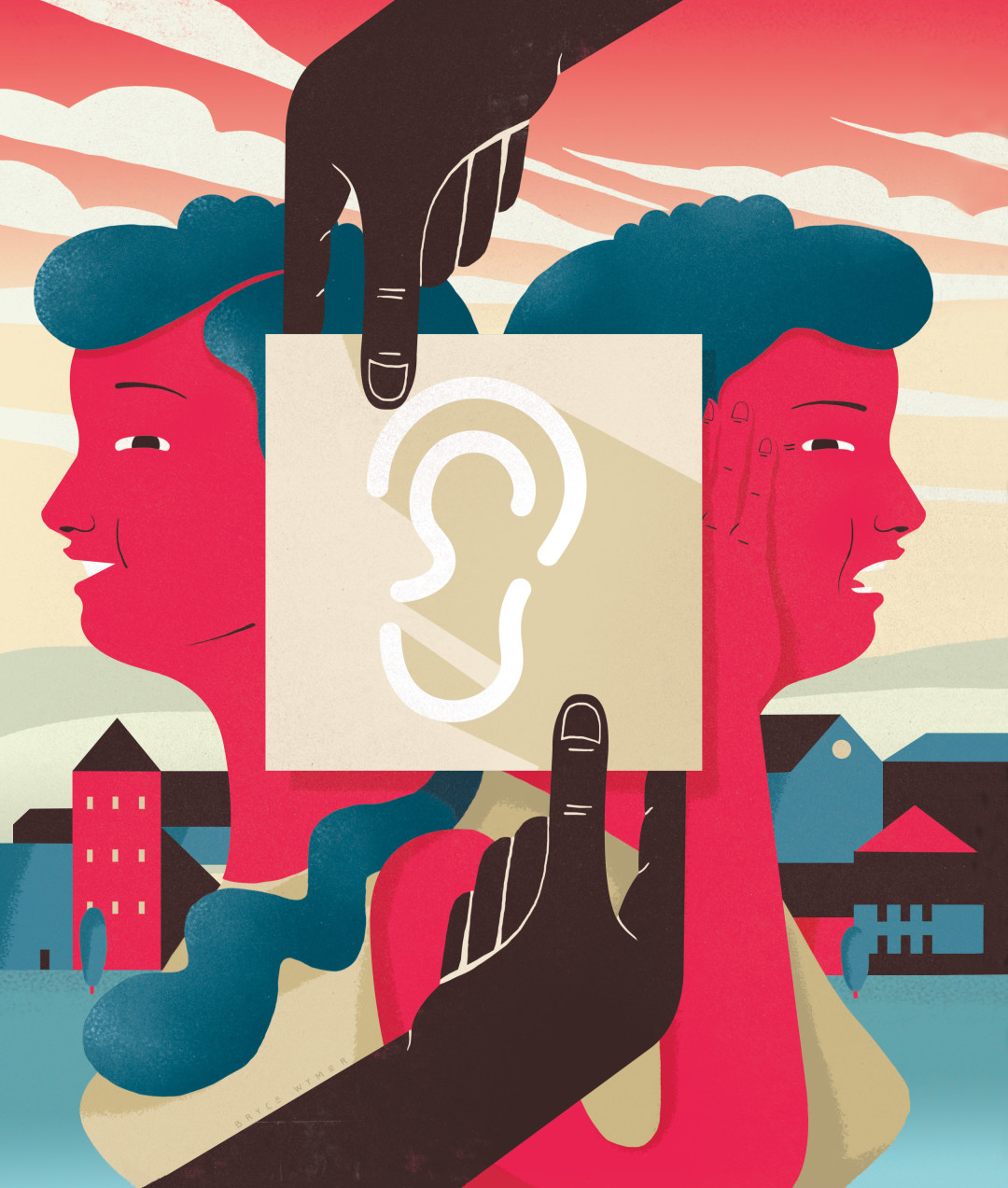Why Did an Ordinary Portland Teenager Suddenly Lose her Ability to Walk and Talk?

The O’Keefe family had an uneventful Thanksgiving 2012. Daughter Kylie, a 16-year-old vegetarian, didn’t eat turkey; her sister Kiara, a little more than four years younger, did. Over the next few days, both girls began vomiting.
“Kylie throwing up was gut-wrenching—violent, loud,” recalls Kevin O’Keefe, the girls’ father. Still, Kevin and his wife, Donna, were not especially concerned. Kids get sick. Kylie, especially, had been through the ringer. After a fall down the stairs two years before, she experienced migraines and memory issues. “She didn’t remember this was her home,” says Donna, sitting in the kitchen of the family’s house in a quiet Happy Valley subdivision. But the high school junior had regained her memory, was taking AP classes, and hoped to graduate early.
Three weeks after Thanksgiving, after a brief rally, she was sick again. On a day she decided to brave school, she vomited by lunch and, more alarmingly, began wandering in confusion and talking strangely. “There was a clicking sound in her voice that had never been there before,” Donna says. Kylie’s head was also killing her, and she was having serious, alarming balance issues.
“The term ‘drunken sailor’ comes to mind,” her father recalls. “I mean, weaving within a three-feet-wide area.”
The next morning, Kylie landed in the emergency room. The hospital did an MRI and an EEG. Everything looked normal. Kylie’s neurologist, with whom she had consulted periodically since the fall down the stairs, arrived. “He said, ‘We think it’s conversion disorder,’” Donna says—the modern term for emotional crisis manifesting as physical symptoms, once called “hysteria.” Did this explain the headaches, vomiting, speech troubles, and balance issues? Yes, the neurologist said. But Kylie, when she was able to form words, insisted there was something physically—not psychologically—wrong.
Months later, a second neurologist diagnosed a migraine. But migraine medicine did little to improve Kylie’s condition. She was hypersensitive to sound, her speech turned halting and glottal, and her writing devolved into what Donna calls “chicken scratch.” Most terrifyingly, pain sometimes drove her into a catatonic state the family called “absence seizures.” Her parents began shooting video footage that bears a distinct tinge of horror-movie dread, the girl looking ravaged and haunted. Finally, a psychologist said he was convinced there was indeed a physical reason for the girl’s symptoms. What the problem was, however, and what could fix it, he could not say.
In the 1980s, a Portland ear specialist named F. Owen Black became known for performing surgery to repair a perilymph fistula (PLF), an abnormal hole between the middle and inner ear. Whether congenital or caused by injury, the condition provoked dizziness, nausea, headache, imbalance, and heightened sensitivity to sound. Black surgically repaired many PLFs, but the condition was a source of controversy, due in part to its wide variety of symptoms. Doctors, researchers, and medical schools debated the condition’s very existence.
Ashley Wackym, a 1985 graduate of Vanderbilt University’s medical school, came to Portland in 2009. The vice-president of research at Legacy Health kept seeing symptoms that fit either PLF or a similar condition, superior canal dehiscence. Though the hole in SCD is in a slightly different location, patients experience similar phenomena. “Loud sounds make them dizzy and nauseated,” Wackym says. “They hear internal sounds unusually well—some patients hear their eyes move or blink.”
Sitting in his office at North Portland’s Legacy Emanuel, Wackym shows on a model human ear how tiny and hidden these holes can be. “People keep going to doctor after doctor over years, decades,” he says. “They get a normal MRI, a normal CT scan, and are told, ‘There’s nothing wrong with you. It’s all in your head.’”
And it is—more specifically, it’s in their ears. Both conditions disrupt the autonomic nervous system and hippocampus, which, in Wackym’s words, “really screws up people’s cognitive function.” Wackym typically performs five PLF or SCD surgeries a week, patching the holes with soft tissue from behind the ear. His expertise in making these diagnoses is relatively rare, and Wackym says nearly all his patients come to him in desperation. On a private Facebook group page devoted to PLF surgery, he’s become something of a superstar.
“A couple of days ago, I got a call from a woman in Norway who found out about me,” he says. “They’ve got nobody in Norway who does this.”
Results can be dramatic. One 6-year-old patient endured extensive testing at a local children’s hospital. A pre-op photo of the boy shows his face sagging in pain. “The final diagnoses,” Wackym noted in a paper, “were adjustment disorder with anxiety and obsessive-compulsive disorder. His mother ... was told that she was an enabler.” Wackym performed SCD surgery on the boy. Another photo shows the child, post-op, all smiles. Several years later, he remains healthy.
The O’Keefes found Wackym in the spring of 2013. Kevin’s videos showed his daughter deteriorating: caroming off walls, clicking as she tried to get words out, and curled in a fetal position, holding her head. Kylie had taken to wearing shooting range–style earphones, because even whispers caused excruciating pain.
To narrow down possibilities, Wackym recommended an elevator ride. “These patients are super-sensitive to barometric pressure and altitude,” he says. “I said, go to the US Bancorp Tower and ride up to Portland City Grill.” Kylie collapsed on the descent. Wackym theorized that Kylie’s prolonged vomiting had opened a hole in her ear, perhaps originally caused by the fall years earlier. He scheduled surgery for August.
It hadn’t been a pleasant year for the O’Keefe family. Younger daughter Kiara was diagnosed with an auto-
immune condition; Kevin had his prostate removed. And, before discovering Wackym, Kylie had encountered suspicion. Was she on drugs? How was the O’Keefes’ marriage? Doctors would take Kylie into separate rooms and ask about abuse, perhaps sexual abuse. “Psychologists would ask questions to steer me in a certain direction,” says Kylie now, from her dorm room at Whittier College in Southern California. “I’m like, that’s not what I’m saying at all, you’re twisting my words—which is even more difficult because it’s hard enough for me to get those words out.”
Wackym’s surgery took a little more than an hour. Soon after, Kylie asked her dad to get her a pizza.
“We had our daughter back,” Kevin says.
Spring 2015 finds Kylie in her second college semester, majoring in art, hoping to go into game art and digital animation.
Kylie does not recall some of the misery of the preceding nine months. She remembers that she sometimes she felt hopeless—but never completely. “Hope was the only thing I had,” she says, “because doctors didn’t believe me, we weren’t getting anywhere, and no one was really understanding me. If I lost hope, then I would just have nothing.”
Several months after Kylie’s surgery, a neighbor started to complain of symptoms similar to her old condition. The O’Keefes recommended Wackym, who operated. Kylie visited the neighbor afterward.
“We were talking about how the room spins,” she says. “It’s crazy that someone next door was experiencing the same thing.”
Or maybe it’s not so crazy. How many people have been doomed to a lifetime of suffering and misunderstanding, when the fix is a tiny patch over a tiny hole? Hopefully, the answer is fewer and fewer still.




